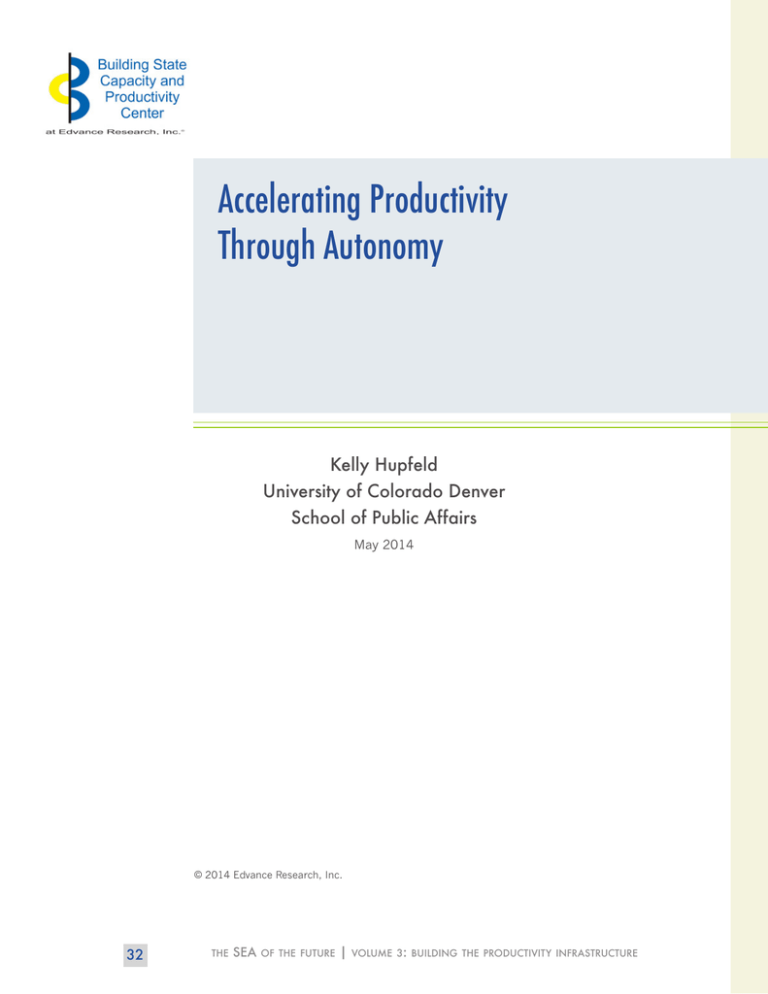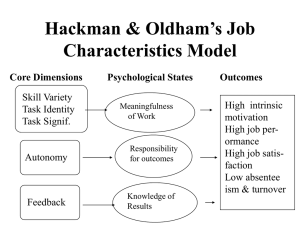Accelerating Productivity Through Autonomy
advertisement

Accelerating Productivity Through Autonomy Kelly Hupfeld University of Colorado Denver School of Public Affairs May 2014 © 2014 Edvance Research, Inc. 32 the SEA of the future | volume 3: building the productivity infrastructure Accelerating Productivity Through Autonomy Education is a complex undertaking—there is no single policy reform that will guarantee the academic performance of every student, at every school, every day. Improvement requires experimentation. At the same time, we want every dollar leveraged toward maximal effect. To meaningfully improve educational outcomes and accelerate productivity, we must enable those responsible for public education to adapt their approaches and learn as they go. The high-performing school system of the future will be driven by continuous improvement. And it most likely will be successful because of, not in spite of, the role its state education agency plays. To support districts and schools in their work to improve outcomes for students, states cannot stand in the way with a set of mandates and prescriptions. Rather, they need to carefully reassess and revise state laws and regulations to encourage high-quality local decisions and unleash the creativity and skill of teachers, principals, and school system leaders. Balanced with the right incentives and support for the talent in our schools, these efforts offer tremendous potential to get the most out of the resources and energy we put into public education. To promote autonomy in a way that will advance productivity, states should be agnostic in terms of how schools are structured and instead focus on removing barriers and providing resources to benefit all types of schools. To promote autonomy in a way that will advance productivity, states should be agnostic in terms of how schools are structured and instead focus on removing barriers and providing resources to benefit all types of schools.1 Too often state policies, while well intentioned, constrain the authority of local education providers, as well as the ability of school and district personnel to make timely decisions about the learning needs of individual students and schools. Examples of these policies include: • Laws that restrict how districts and schools use state funding—be they artifacts of past theories of action about improving education, efforts to protect against fiscal malfeasance, or conservative interpretations of federal funding requirements. • Laws that bestow tenure on teachers regardless of effectiveness, make it prohibitively costly and burdensome to remove ineffective teachers, require 1. See Martin Orland, “The Supply’s the Limit: Meeting the Challenge of Knowledge and Capacity Constraints to Significant Educational Improvement,” Education Finance and Policy 6, no. 1 (2011): 1-17. 33 the SEA of the future | volume 3: building the productivity infrastructure Accelerating Productivity Through Autonomy that educators hold certifications that are not shown to be related to effectiveness, and fix the distribution of personnel by placing limitations on class sizes. • Laws that constrain the variety and design of permissible learning environments. These can include limits on the number of autonomous schools, like charter and innovation schools, or restrictions on the time and place of learning. While these policies were often initiated in an effort to develop minimum standards and equity in education, they can also hinder innovation and differentiation. But states do have opportunities and policy mechanisms to promote autonomy. Whatever their starting point, states can develop a policy approach that offers flexibility to teachers, principals, and superintendents without undermining states’ fundamental obligations for the health and safety of students, the responsible use of public funds, and the overall performance and equity of the education system. CREATING A STATE POLICY FRAMEWORK THAT LEVERAGES SCHOOL AUTONOMY States interested in fostering greater school and district autonomy can start assessing existing state statutes, regulations, and other policies. This audit should focus on the extent to which state policy permits and encourages local decisionmaking about the deployment of financial and other resources; personnel; and the design, implementation, and oversight of a variety of optimal learning environments for students. The results of the audit should provide a solid foundation for identifying missing or contrary policies. Resource Autonomy Improving school quality means that teachers and leaders must be able to deploy resources to meet individualized needs in a flexible and timely way. School funding policies in many states are designed primarily to protect against local misuse—a laudable goal, but one that must be balanced with the need for local freedom to determine what resources are needed for what purpose. States promote productivity by: • Permitting flexibility in the use of state and local education funds so that local decisionmakers can drive the money where it is most needed. • Providing additional resources based on individual student characteristics (e.g., special education status) so that schools can address the special needs of individual learners. 34 the SEA of the future | volume 3: building the productivity infrastructure Accelerating Productivity Through Autonomy • Designating charter schools as local education agencies rather than treating them as part of an existing district, making them eligible to receive certain federal funds and grants. By contrast, states hinder autonomy, and thus productivity, when they set up school finance formulas that tightly restrict the ways in which funds can be distributed and used, or impose such demanding reporting requirements that districts limit their use of funds just to ease the reporting burden. As Miller, Roza, and Simburg report in their essay, “Funding for the Students’ Sake,” when funds are deployed on the basis of inputs—such as staff positions—district and school leaders cannot repurpose funds to support tailored instructional programs. Of course, some of these constraints are federally imposed and states cannot change them on their own. But others are not: California recently devolved a substantial amount of resource decisionmaking to districts with its Local Control Funding Formula, eliminating many state-imposed revenue constraints and categorical programs. School and district leaders must be free to find the best ways to hire, train, evaluate, and reward their staff, and to dismiss staff members who are unable or unwilling to fit into a school’s vision. Personnel Autonomy Measurably improving student outcomes requires highly capable professionals able and willing to adjust the learning environment to meet the needs of individual students. School and district leaders must be free to find the best ways to hire, train, evaluate, and reward their staff, and to dismiss staff members who are unable or unwilling to fit into a school’s vision. States can promote this autonomy through policies that permit staffing decisions such as hiring, layoffs, and termination to be made at the school level, based on student and school needs, and through policies that permit or encourage differentiated recognition and rewards for educators. In Indiana, for example, the legislature passed a law authorizing principals statewide to dismiss teachers who have received two consecutive “ineffective” ratings or three “needs improvement” ratings in five years. The Louisiana legislature passed an initiative that requires teacher salary schedules to be based on effectiveness, demand, and experience; none of those elements can exceed half the formula. 35 the SEA of the future | volume 3: building the productivity infrastructure Accelerating Productivity Through Autonomy On the other hand, states can stand in the way of autonomy with policies that: • Restrict the ability of a school’s leadership team to make timely decisions about which staff members are the best fit for the school’s mission. • Require the application of districtwide collective bargaining agreements without regard for differences in school settings. • Mandate the assignment of personnel based solely on student counts. • Mandate particular forms of teacher evaluation. Autonomy on Learning Environments The extent to which teacher evaluation is useful depends on how evaluation data are integrated into other aspects of the talent management system. An optimal state policy framework defines the expected educational outcomes (the “what”) while permitting local discretion in setting up and overseeing learning environments that best fit the needs and resources of students and the community (the “how”). States promote local control over the “how” by permitting qualified entities other than traditional districts, such as nonprofit organizations, to operate schools, and by allowing for a variety of types of school structures ranging from traditional to online to autonomous, including charter, innovation, and pilot schools. States can also anticipate a variety of fluid learning environments within schools—such as those incorporating blended learning—and accommodate a range of local decisions about the school calendar and length of the school day. Colorado does this through its Innovation Schools Act, which authorizes waivers of state and district policies for schools seeking to operate in innovative ways. In Tennessee, any local board of education may initiate a program of school-based decisionmaking and designate areas that can be decided by school personnel, including classroom teachers. These areas include (but are not limited to) management, curriculum, classroom management, professional development, and budget. States can also enable diverse learning environments to flourish by allowing families to find the school that best meets their child’s needs through school choice, access to useful information about school options, and resources such as transportation options that make choice meaningful. Conversely, most states set up obstacles by requiring districts and schools to follow a prescribed curriculum and use preselected texts, setting arbitrary caps on certain types of schools such as charter schools, and basing policies 36 the SEA of the future | volume 3: building the productivity infrastructure Accelerating Productivity Through Autonomy on assumptions that there is one right way—and thus certain specified structures—to educate students. POLICY IS ONLY HALF THE BATTLE The value of local autonomy is not a new notion in public education. Site-based school management, in which decisions about resources are devolved to the school level, has been around since the 1970s. Charter school laws and other laws creating different types of autonomous schools represent more recent variations on this theme. Autonomy is merely a mechanism through which professional judgment and leadership may be exercised. Leveraging autonomy to promote productivity will require investments in school capacity and incentives for doing better. Research on the effectiveness of autonomous schools is mixed. Studies of autonomous schools reveal principals embracing autonomy to build a coherent faculty and rapidly adapting teaching and learning to meet students’ needs and even outperforming their peer schools.2 Still other research shows principals of autonomous schools struggling to get a foothold. As CRPE’s Betheny Gross wrote in 2011 about autonomous charter school leaders, “powerful forces constrain the creativity of…school leaders, lessen their resolve to make big changes, or overwhelm their efforts to do so.”3 We know that removing barriers alone will not bring improvement. Autonomy is merely a mechanism through which professional judgment and leadership may be exercised. Leveraging autonomy to promote productivity will require investments in school capacity and incentives for doing better. Areas where states can help districts and schools build and maintain the skills and capacity to act effectively on their autonomy include: • Building a talent pipeline. States can set standards for teacher and school leader preparation programs that focus on training graduates to develop and operate effectively in learning environments that are individualized for the needs of each student, set rigorous entrance requirements for those programs, and allow flexibility in the design of preparation programs so that districts and schools can best meet their staffing needs. 2. Matthew P. Steinberg, “Does Greater Autonomy Improve School Performance: Evidence from a Regression Discontinuity Analysis in Chicago,” Journal of Education Policy and Finance 9, no. 1 (2014): 1-35. 3. Betheny Gross, Inside Charter Schools: Unlocking Doors to Student Success (Seattle: Center on Reinventing Public Education, 2011). 37 the SEA of the future | volume 3: building the productivity infrastructure Accelerating Productivity Through Autonomy • Funding comprehensive assessment and data systems. Strong systems allow teachers and school leaders to have valuable real-time information about student learning, the effectiveness of instructional techniques and interventions, and even their own professional development needs. • Replicating best practices. States can provide funding to encourage experimentation and to help districts and school leaders identify and replicate effective school designs and approaches. Boundaries and Direction on Autonomy State policy frameworks that support the use of autonomy will provide clarity about the expectations of student learning outcomes and the consequences for districts and schools that fail to achieve these outcomes. Without clear direction and meaningful consequences for failure, schools and districts are not likely to put in motion the courageous but painful decisions that must be made for all students to succeed. The incentives for improving educational outcomes for all students must be stronger than the incentives to conduct business as usual. The incentives for improving educational outcomes for all students must be stronger than the incentives to conduct business as usual. States can make this happen by setting clear standards about what students should know and be able to do in essential learning areas. They also need to set robust performance standards for schools and districts that are focused on rates of student growth, equity in outcomes across student groups, and other outcome measures deemed essential by the state, such as graduation rates. The state accountability system should require persistently failing districts to dramatically change what they are doing or be placed under a recovery authority that is structured to operate with high levels of autonomy and capacity. In Louisiana, the lowest-performing schools will, if they don’t improve, move under the authority of the state-run Recovery School District. In Indiana, schools designated as Turnaround Academies because of low performance are not covered by collective bargaining agreements and thus can make changes to staffing that leaders think will improve results. DIFFERENTIATING AUTONOMY: EARLY ADOPTERS AND CAUTIOUS CONSUMERS In considering how best to promote autonomy, state policymakers should also consider the culture of the state and the readiness of districts and schools for change. Districts vary tremendously in terms of their capacity, resources, and motivation for change. It is useful here to borrow terms from the business sector to think about encouraging and supporting innovation.4 4. With appreciation to the concepts expressed in Kim Smith and Julie Petersen, Pull and Push: Strengthening Demand for Innovation in Education (Boston: Bellwether Education Partners, 2011). 38 the SEA of the future | volume 3: building the productivity infrastructure Accelerating Productivity Through Autonomy Some districts will be early adopters, eager to experiment and capable of marshaling national resources to do so. Many early adopters are proactive urban districts looking to launch schools out of decades of failure. Some early adopters are forced into innovation through state takeover or some other aspect of accountability systems. The state’s goal should be to ensure that the early adopters, who are acting as laboratories for innovation, have the policy environment they need to develop and maintain autonomous schools. In some cases, states may act to ensure the early adopters have sufficient capacity to make the experiments worthwhile. Some early adopters will attract national funders; the main help the state can provide them is to remove unnecessary barriers and otherwise get out of the way. Another way to accelerate this autonomy is to focus initial policies granting autonomy on the state’s high-profile urban districts. In contrast, other districts will fall into the role of cautious consumers in a culture that has long been risk-averse. In the longer-term view, the state’s role is to spread and sustain what works and to support educators in their learning while differentiating among the needs of different districts. Above all, the state should seek to reliably recruit and train educators who possess the professional judgment that will be needed in the schools of the future, and to generate the resources and supports needed for those schools to operate effectively. As David Plank and BetsAnn Smith point out, “the demands of advancing a coherent system of supports for effective teaching and learning almost always outstrips the professional, technical, and fiscal resources of individual schools.”5 A long-term view of state policy will ensure that the coherent system of supports exists when schools and districts are ready to transform. The state should become a marketplace for the exchange of information about educational performance and improving educational practices so that local decisions are well-informed. This marketplace can and should exist in multiple formats such as webinars, online discussions, structured leadership programs that combine key problem-solving skills with the application of those skills to local problems, online wikis and databases of instructional and operational tools, conferences, peer mentoring programs, and so on. The state should pay careful attention to the needs of more isolated schools and districts, and other communities with less capacity. Finally, state education leaders should become the top advocates for the new approach to schooling and refuse to engage in sound bite policymaking that implies that any one approach, including autonomy, is the silver bullet we have all waited for. The deep and complex change necessary to arrive at the levels of education productivity we now expect requires courage from our politicians and policymakers, as well as from our educators. 5. David N. Plank and BetsAnn Smith, “Autonomous Schools: Theory, Evidence and Policy” in Handbook of Research in Education Finance and Policy, ed. Helen F. Ladd and Edward B. Fiske (New York: Routledge, 2008), 402-425. 39 the SEA of the future | volume 3: building the productivity infrastructure




